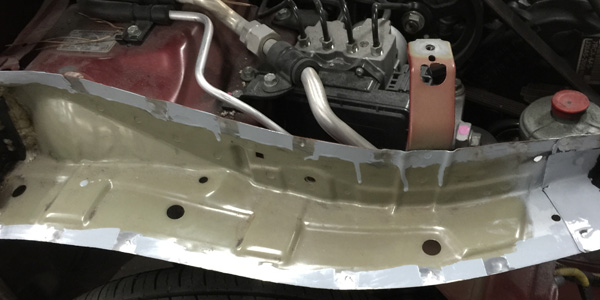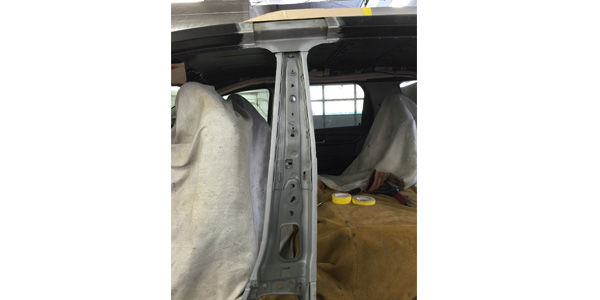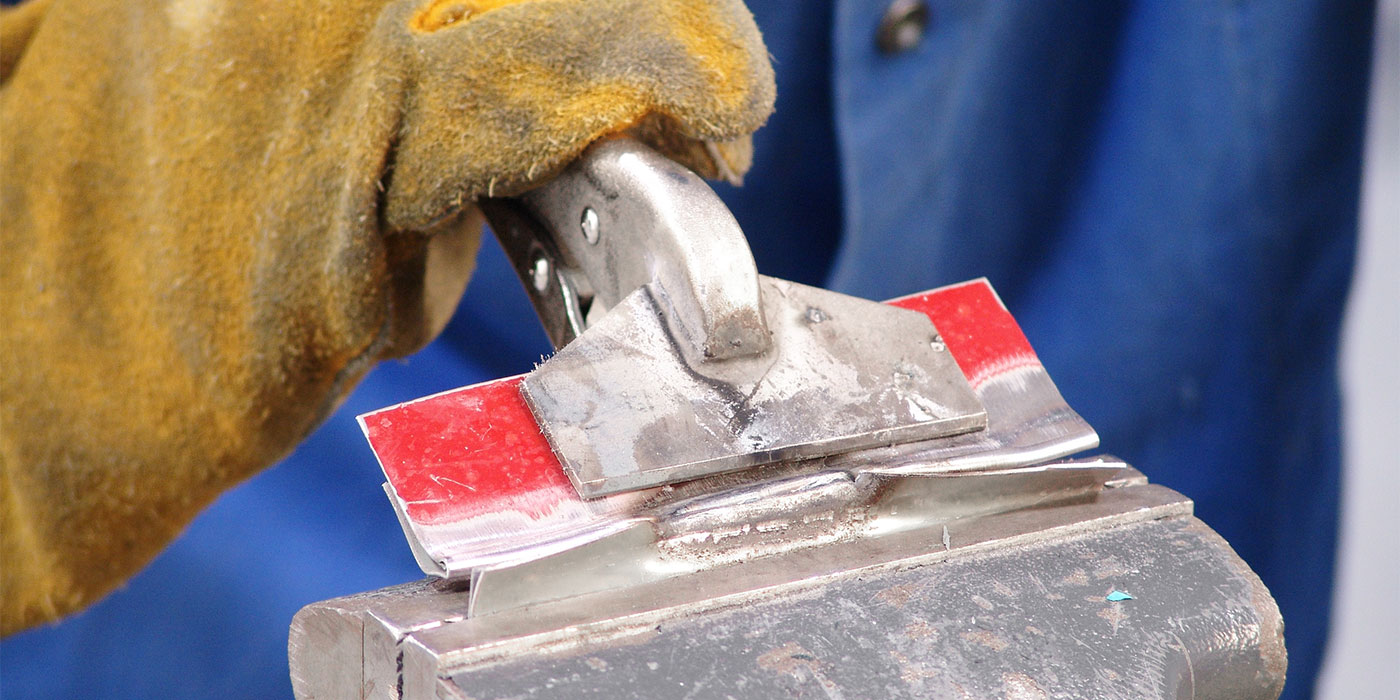
Vehicle manufacturers are building the vehicles of today lighter, stronger and to last longer. New construction materials along with different metals and strengths of various steels must be combined or held together to meet the new safety and CAFÉ requirements. There are adhesives, screws, bolts and rivets, along with other fasteners or combinations of fasteners to bond a vehicle and all its components. But as of today, the spot weld is still king of bonding or fastening during new-build construction or repair. With thousands of welds per vehicle, this does not look to change soon.
Different Types
We have different types of welding to choose from: squeeze-type resistance spot welding (STRSW), MIG/MAG plug welds and seam or stitch welds.
MIG brazing is being recommended more and more. We also have combinations of welding and adhesives for weld bonding and the use of seam sealers in the weld zone for seam welding. Recognizing the correct way to reassemble a vehicle is critical. I dare to say welding is the most critical procedure technicians will do, as quite literally people bet their lives on their welds.
Why STRSW?
The reasons why particular welds are used during construction and repair are growing as heat becomes a major detriment to high-strength steel and ultra- high-strength steel, or HSLA steel, during welding. It sounds odd as heat is needed to make a weld, but the surrounding area of the steel being welded can be damaged by what is referred to as the “heat affect zone” or HAZ. The heat radiating out can change the properties of the steel surrounding your weld and weaken the area.
Another factor that’s really starting to come into play is corrosion. Steels are becoming stronger even as they become thinner. The new steels also corrode faster. Preventing corrosion is an absolute. You can have the best weld fail very quickly if corrosion protection is not applied correctly.
Corrosion protection must be considered in all aspects of repair. Vehicles today are built to last much longer than in the past. In 2015, the average life of a vehicle was 11.5 years. It’s becoming fairly common to see vehicles go past 250,000 miles and push 300,000. My own 2000 K series pickup is at 280,000 miles and looks and runs great. This longevity also must factor into all equations as we offer a lifetime warranty on repairs.
The Purchase
All shops that have made the investment and purchased an STRSW machine have seen obvious benefits right from the start. I commend these shops as I know STRW machines are expensive.
As technicians started using the machines, they saw the time savings right away. The prep time is a little longer to start, but the absence of dressing the welds is a major time-saver, particularly in large jobs. The overdressing of welds is a common issue in shops as technicians using plug welds grind metal too far down, which may weaken the weld dramatically. As we continue learning about manufacturing processes, we learn that even one failed weld can cause issues.

This brings up another benefit of the STRSW process. The speed of the weld creates a very low HAZ, which not only keeps the surrounding metal from being damaged but also helps to reduce the corrosion created from heat. This advantage needs to be considered by all shops that have not purchased an STRSW machine. Plug welds have a tremendous HAZ zone and create a corrosion hot spot on every weld. We have products to prevent corrosion, but access and application is difficult. I know that even factory welds rust, as vehicle manufacturers aren’t perfect, but the problem is they do not offer a lifetime warranty. Body shops do. Will your welds last the test of time?
Consider also that some vehicle manufacturers are no longer making MAG welding an option. Metal Active Gas or GMAW (wire feed welders) set up with mixed gas may not be an acceptable on their cars. STRSW with the option of MIG brazing would be the only choices. The damage to metal and the corrosion issue mentioned before are major concerns.
Preventing Corrosion
As I said before, STRSW is not perfect. There are some procedures that can be done to increase the consistency during the repair.
In watching shops adopt these procedures, the repair time has not changed noticeably and the repair quality has gone up dramatically.

I have asked some shops what they do to prevent corrosion, and these are the suggestions they gave. One problem they’ve seen is corrosion in between the spot welds. To prevent this corrosion, here are some simple tips. These are based on having the right machine and the right amount of power to that machine. These are just weld and weld zone procedures. Weld bonding and seam welding will be talked about later.
- Be sure all tips are clean and correct for application and that tips are aligned. STRSW is great when done correctly. If not, it’s just another failed weld. Porosity will create corrosion on these welds or the blowout will create a corrosion hot spot.
- Mark welds and remove primers and coatings only on weld locations. Many technicians strip the whole mating surface, which leaves large areas of bare metal between the welds. Cavity waxes and seam sealers may not be an option or may be difficult to apply correctly.
- Cover the bare metal spot with ¾-inch tape. If the entire flange was exposed to bare metal, do the same where the welds are marked. Scuff any primed or bare metal areas. Using a wool dauber, apply only non-reduced epoxy primer in one direction to bare metal.
- Remove the tape and apply the weld-through primer if the vehicle manufacturer calls for it.
- Be sure to tape all vice grips except for the shunt clamp. This will allow the proper current for the weld and save mushrooming of the tips. Use the shunt clamp correctly.
These same procedures also work for plug welds. Just remove the weld-through primer, if applied, from the weld zone prior to welding. I’ve also seen shops jamming parts and enclosed areas with epoxy primer first, then welding panels together. This improves corrosion protection dramatically in areas such as rockers and wheel wells or any other areas that have high-moisture exposure or just limited access after welding.
Weld Bonding
When STRSW machines became available, the repair industry saw an effective way to duplicate the factory build process. When weld bonding became prevalent, we saw a way to add longevity to repairs. STRSW and adhesives in combination has solved problems that vehicles used to have in the past. By welding through the adhesive, we see so many advantages to the manufacturer and the repair shop. It adds an amount of strength, reduces flex and noise, vibration and harshness (NVH).
One of the main things I like is the corrosion protection. The steps mentioned earlier are to help prevent corrosion between welds. Weld bonding also does this. When done properly, the adhesive acts as a sealer to prevent moisture from entering but to also separate the metal-to-metal contact that can create corrosion hot spots from flex and vibration. The use of weld bonding can and does make for a good, long-lasting repair.
When using weld bonding, be sure the STRSW machine you have has the capability to do so. Also, be sure to do test welds and peel tests to ensure that the weld and bond is correct. Weld bonding should only be used where vehicle manufacturers call for the procedure. Keep in mind also that a shunt clamp is required to do weld bonding correctly.
Seam Welding
Seam welding is something newer to the repair industry. It’s similar to weld bonding but should never be used in place of weld bonding.
Seam welding is applying seam sealer to the weld bonding area. When the welds are complete, just remove excess materials and you have welded and seam sealed at the same time. The sealers do not offer strength to a vehicle like adhesives during weld bonding, but they do offer the corrosion protection that adhesives do. This addresses the concern of bare metal between welds and applying cavity waxes and seam-sealing edges. It’s definitely a time-saver and reduces waste of seam sealers during application.













